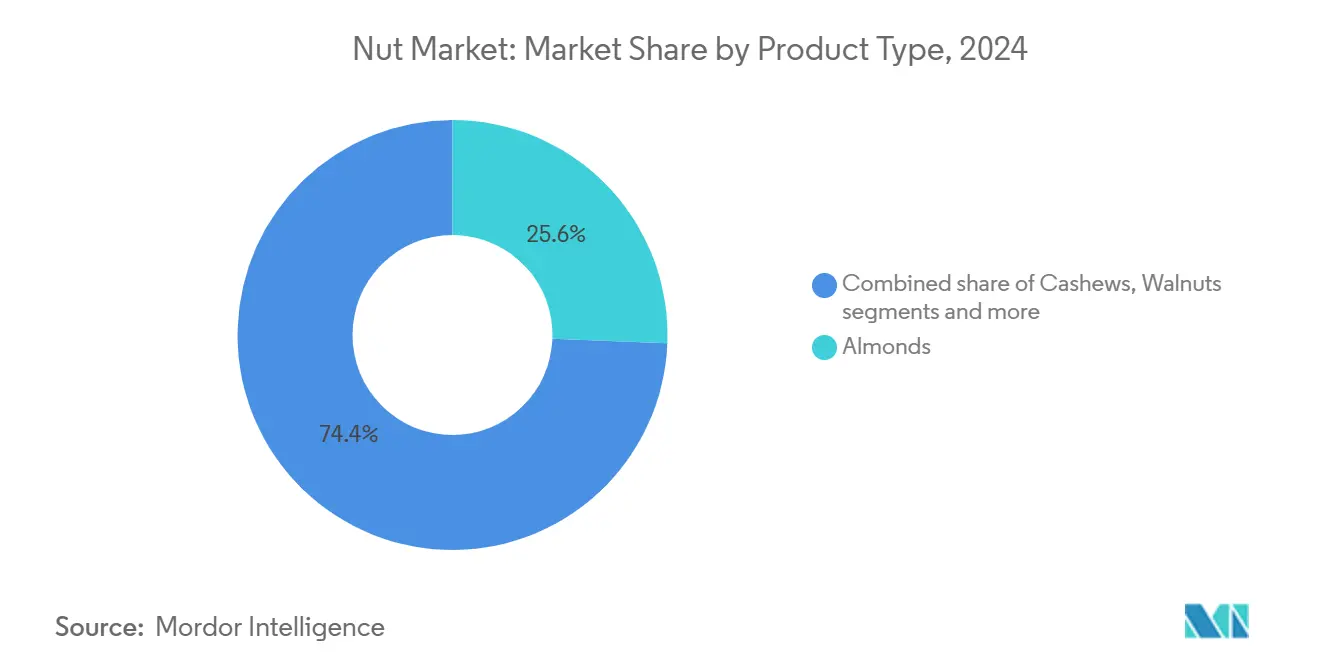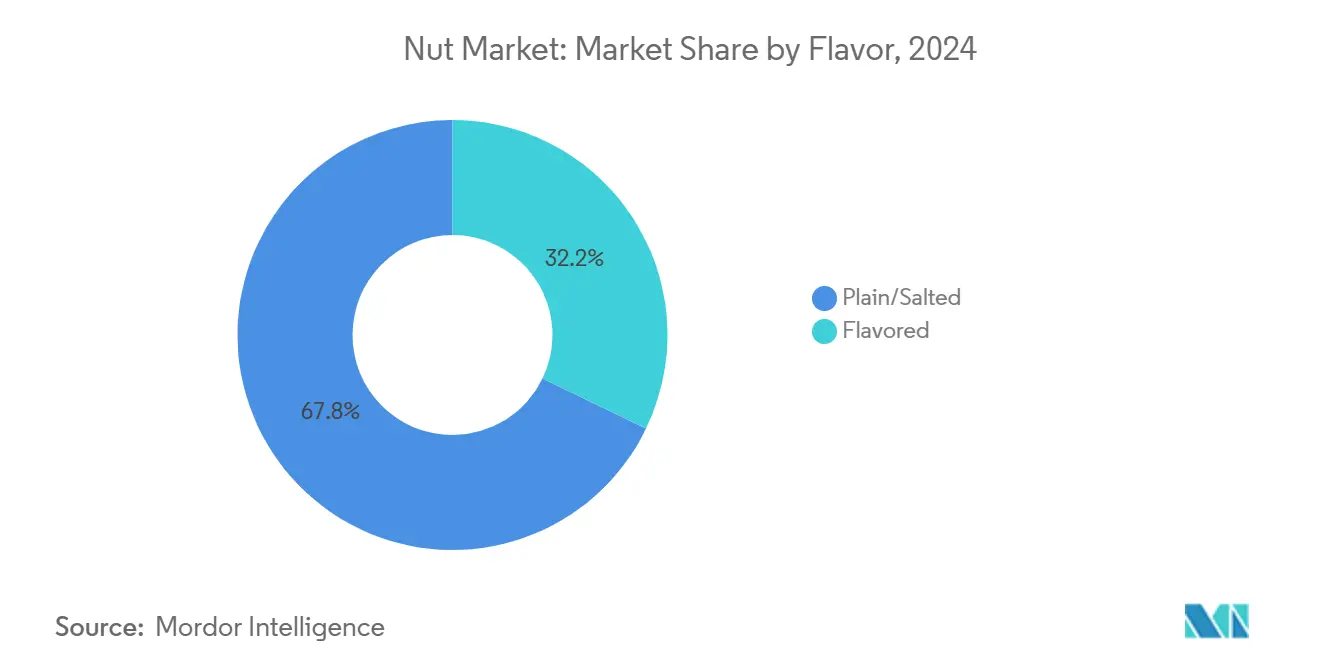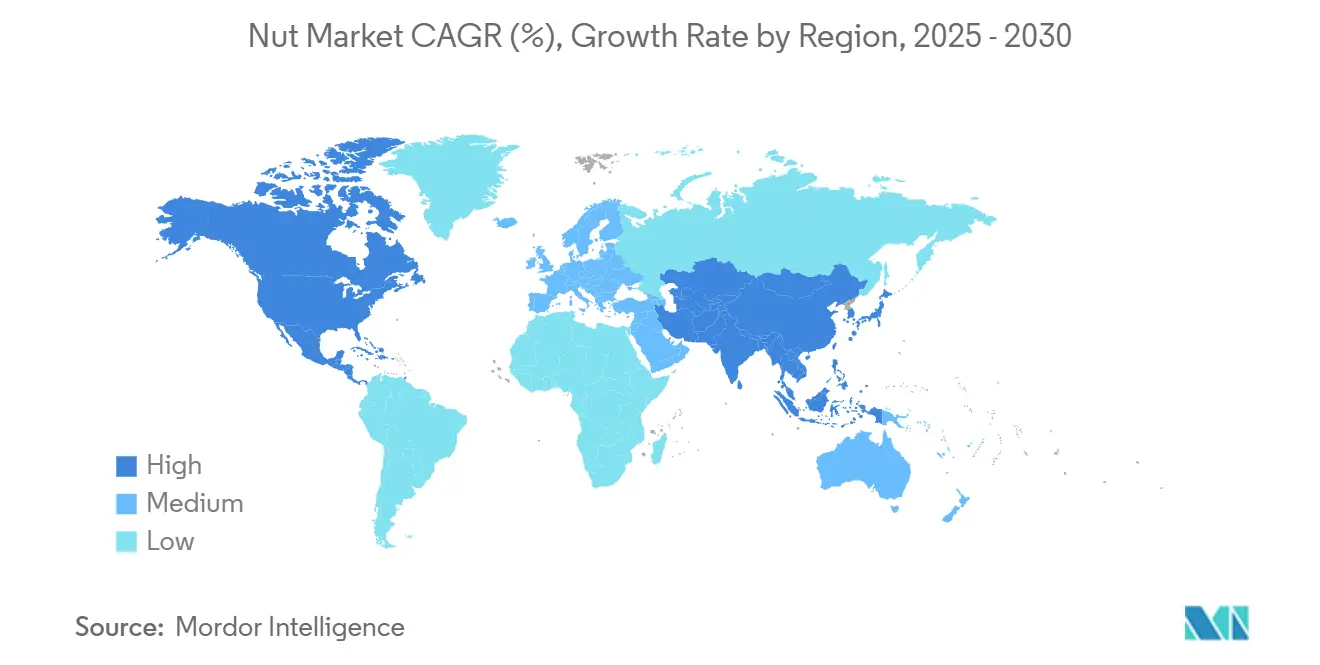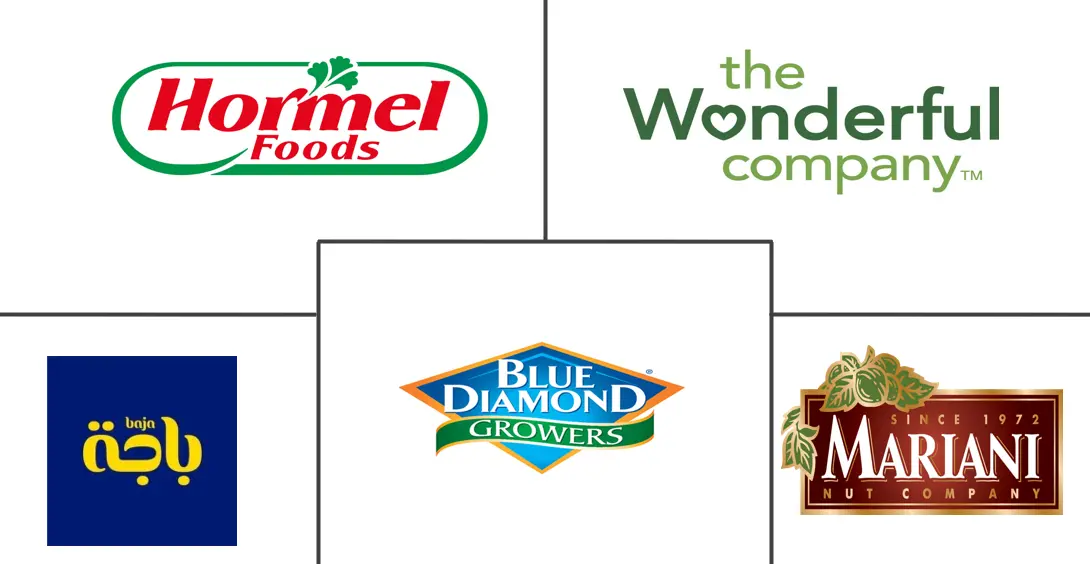
Nut Market Analysis by Mordor Intelligence
The nuts market size is estimated to be USD 37.20 billion in 2025 and is forecast to reach USD 48.82 billion by 2030, advancing at a 5.58% CAGR. This growth is driven by increasing consumer demand for nutrient-dense snacks, as nuts are widely perceived as both premium and functional foods offering health benefits. The expanding cultivation of nuts ensures a consistent supply to retail shelves, even as consumer preferences diversify. Europe continues to dominate the market, supported by well-established consumption habits and a sophisticated retail infrastructure that facilitates widespread availability. In contrast, the Asia-Pacific region is experiencing the fastest growth, as urban consumers increasingly shift towards healthier protein alternatives, reflecting a broader trend of health-conscious eating. Product innovations, including spicy, fruit-infused, and functional coatings, are expanding the market's reach by appealing to a wider consumer base. Furthermore, advancements in automated processing technologies are reducing unit production costs, helping manufacturers maintain stable profit margins despite volatility in raw material prices.
Key Report Takeaways
- By product type, almonds led with 25.61% revenue share in 2024; pistachios are projected to grow at a 5.89% CAGR to 2030.
- By category, conventional formats held a 74.28% share of the nuts market in 2024, while natural and organic formats are forecast to expand at 6.26% CAGR through 2030.
- By flavor, plain and salted varieties accounted for a 67.83% share of the nuts market in 2024; flavored formats will climb at a 5.99% CAGR through 2030.
- By distribution channel, supermarkets and hypermarkets controlled a 45.72% share of sales in 2024, whereas online retail is set to rise at a 6.35% CAGR to 2030.
- By geography, Europe contributed 39.72% of global revenue in 2024; Asia-Pacific will post the fastest CAGR at 6.42% through 2030.
Global Nut Market Trends and Insights
Driver Impact Analysis
| Driver | (~) % Impact on CAGR Forecast | Geographic Relevance | Impact Timeline |
|---|---|---|---|
| Nutritional Benefits Associated with Nuts Consumption | +1.2% | Global, with stronger impact in North America and Europe | Long term (≥ 5 years) |
| Convenience and On-the-Go Snacking | +0.9% | Global, particularly urban centers in APAC | Medium term (3-4 years) |
| Product Innovation and Flavor Diversification | +0.7% | North America and Europe, expanding to APAC | Medium term (3-4 years) |
| Increased Interest in Organic and Natural Products | +0.8% | North America and Europe, emerging in APAC urban areas | Long term (≥ 5 years) |
| Technological Advancements in Packaging | +0.4% | Global, with early adoption in developed markets | Short term (≤ 2 years) |
| Rising Demand for Raw and Minimally Processed Nuts | +0.6% | Global, stronger in health-conscious demographics | Medium term (3-4 years) |
| Source: Mordor Intelligence | |||
Nutritional Benefits Associated with Nuts Consumption
The nutritional benefits associated with nut consumption serve as a significant driver for the global nut market. Nuts are rich in essential nutrients, including healthy fats, proteins, vitamins, and minerals, which contribute to various health benefits such as improved heart health, weight management, and reduced risk of chronic diseases. According to the United States Department of Agriculture (USDA), nuts like almonds, walnuts, and pistachios are excellent sources of dietary fiber and antioxidants, which support overall well-being. Additionally, the International Nut and Dried Fruit Council (INC) highlights that regular nut consumption is linked to lower cholesterol levels, lower cardiovascular risk in older adults, better cognitive function, and reduced inflammation[1]International Nut and Dried Fruit, "Study Shows Longer-Term Mixed Nut Consumption May Reduce Cardiovascular Risk in Older Adults-January 2025", www.inc.nutfruit.org. The Food and Agriculture Organization (FAO) also emphasizes that nuts play a critical role in addressing nutritional deficiencies, particularly in regions with limited access to diverse food sources. Furthermore, studies from the Centers for Disease Control and Prevention (CDC) indicate that incorporating nuts into daily diets can help reduce the prevalence of obesity and related health conditions. These health benefits, supported by data from reputable government sources and industry associations, are driving consumer demand and fostering growth in the global nut market.
Convenience and On-the-Go Snacking
The increasing demand for convenience and on-the-go snacking is a significant driver of the global nut market. Consumers are increasingly seeking portable, healthy, and ready-to-eat snack options to accommodate their fast-paced lifestyles. Nuts, being nutrient-dense and versatile, have emerged as a preferred choice for such consumption patterns. According to the International Food Information Council (IFIC) report 2024, over 60% of consumers prioritize convenience when selecting snacks, with a growing inclination toward healthier alternatives [2]International Food Information Council, "2024-IFIC-Food-Health-Survey", www.foodinsight.org. Additionally, data from the International Nut and Dried Fruit Council (INC) highlights a steady rise in nut consumption globally, driven by their perceived health benefits and ease of incorporation into daily diets. This trend is further supported by the increasing availability of single-serve and resealable nut packaging, catering to the on-the-go consumer segment. As a result, the convenience factor continues to play a pivotal role in shaping the growth trajectory of the global nut market.
Product Innovation and Flavor Diversification
The market is witnessing significant growth, driven by evolving consumer preferences and innovative product offerings. Manufacturers are moving beyond traditional salted varieties, focusing on flavor innovations that resonate with Gen Z's emphasis on gut health and immune support. This demographic shift is encouraging the incorporation of diverse taste profiles and functional ingredients into nut-based products, enhancing their appeal to health-conscious consumers. The International Nut and Dried Fruit Council is actively promoting nut consumption through a multi-country campaign in Argentina, Brazil, Chile, and Mexico [3]International Nut and Dried Fruit, "INC Unveils Gen Z Preferences for Nuts and Dried Fruits and Snacking in Latin America- July 2024", www.inc.nutfruit.org. By employing culturally specific marketing strategies, the campaign aims to engage younger audiences effectively. Digital platforms and clear nutritional messaging are central to this initiative, ensuring that the benefits of nut consumption are communicated effectively to the target demographic. Advanced processing technologies are also playing a pivotal role in the market. Equipment like FlavorWright seasoning systems enables precise flavor applications while maintaining the structural integrity of nuts. This technological advancement supports the development of premium products with sophisticated flavor profiles, catering to the growing demand for high-quality offerings.
Increased Interest in Organic and Natural Products
The growing consumer preference for organic and natural products is a significant driver in the global nut market. This trend is fueled by increasing awareness of health benefits associated with organic consumption and concerns over the environmental impact of conventional farming practices. According to the United States Department of Agriculture (USDA), the organic food sector has witnessed consistent growth, with organic sales in the United States reaching USD 63 billion in 2023. Similarly, the International Federation of Organic Agriculture Movements (IFOAM) highlights that global organic farmland has expanded significantly, reflecting the rising demand for organic products. In the nut market, this shift is evident as consumers increasingly seek organic nuts, which are perceived as healthier and free from synthetic pesticides and fertilizers. Associations like the Almond Board of California and the International Nut and Dried Fruit Council (INC) report a steady rise in the production and consumption of organic nuts, driven by consumer demand for sustainable and natural food options. This trend is expected to continue during the forecast period, further influencing the global nut market dynamics.
Restaint Impact Analysis
| Restraint | (~) % Impact on CAGR Forecast | Geographic Relevance | Impact Timeline |
|---|---|---|---|
| Supply Chain Disruptions and Raw Material Shortages | -0.8% | Global, particularly California and Mediterranean regions | Short term (≤ 2 years) |
| Tree Nut Allergies | -0.6% | North America and Europe, emerging in APAC urban areas | Long term (≥ 5 years) |
| Competition from Fresh Nuts | -0.4% | Global, stronger in regions with local production | Medium term (3-4 years) |
| Processing Complexity and Cost | -0.5% | Global, particularly affecting smaller processors | Medium term (3-4 years) |
| Source: Mordor Intelligence | |||
Supply Chain Disruptions and Raw Material Shortages
The global nut market faces significant challenges due to supply chain disruptions and raw material shortages. These issues arise from factors such as unpredictable weather conditions, geopolitical tensions, and logistical inefficiencies. The limited availability of raw materials has led to increased production costs, impacting the overall profitability of market players. Additionally, delays in transportation and procurement have further strained the supply chain, causing fluctuations in product availability and pricing. For instance, adverse weather conditions in key nut-producing regions, such as droughts or floods, have significantly reduced crop yields, exacerbating the shortage of raw materials. Geopolitical tensions, including trade restrictions and tariffs, have further disrupted the smooth flow of raw materials across borders. Furthermore, the rising demand for nuts in various industries, including food and beverage, cosmetics, and pharmaceuticals, has intensified the pressure on supply chains. These disruptions collectively pose a considerable restraint on the growth of the global nut market during the forecast period.
Tree Nut Allergies
Tree nut allergies, a significant contributor to the economic burden of food allergies, continue to influence consumer behavior and market dynamics. A substantial portion of the population faces severe health risks, including anaphylaxis, prompting individuals to avoid nut-containing products, which directly suppresses market demand. Manufacturers are further challenged by stringent labeling regulations and the necessity for allergen-free production facilities, driving up operational costs. These issues are exacerbated by growing consumer awareness of food allergies, leading to heightened scrutiny of nut-based products and positioning tree nut allergies as a critical barrier to the global nut market's growth. Additionally, cross-contamination risks during processing and packaging compel companies to invest in specialized equipment and implement rigorous quality control measures, inflating production costs and limiting scalability, particularly for small and medium-sized enterprises (SMEs). The rising demand for nut-free alternatives, driven by consumer concerns over allergic reactions, further diverts spending away from traditional nut-based products, creating additional challenges for market participants.
Segment Analysis
By Product Type: Almonds maintain scale as pistachios quicken
Almonds accounted for 25.61% of the global revenue in 2024, solidifying their dominance in the nuts market, thanks to California's productive orchards and their widespread use as an ingredient. The global demand for almonds continues to rise, driven by their nutritional benefits, versatility in food applications, and increasing consumer preference for plant-based and healthy snacks. Additionally, the growing adoption of almonds in dairy alternatives, such as almond milk, further supports their market growth. Pistachios, benefiting from increased acreage in the U.S. Southwest and surging imports from China, boast a 5.89% CAGR, surpassing the average for the category. Enhanced yields and a premium market stance have bolstered both volume and value for pistachios.
The pistachio market is also witnessing growth due to its positioning as a premium snack and its use in confectionery, bakery, and culinary applications. Rising health awareness and the promotion of pistachios as a source of protein and healthy fats are further driving their demand globally. The expanding middle-class population in emerging economies, particularly in Asia-Pacific, is contributing to the increased consumption of pistachios, supported by improved distribution networks and marketing efforts.

Note: Segment shares of all individual segments available upon report purchase
By Category: Conventional still dominates but organic scales up
In 2024, conventional products dominated the global nuts market, capturing 74.28% share, thanks to their alignment with mainstream price points and the advantages of well-optimized supply chains. Conventional nuts continue to benefit from established production processes, widespread availability, and cost efficiency, making them the preferred choice for a majority of consumers worldwide. These products are supported by a mature supply chain infrastructure that ensures consistent quality, competitive pricing, and widespread distribution across various regions. Additionally, the affordability of conventional nuts makes them accessible to a broader consumer base, further solidifying their dominance in the market.
However, natural and organic offerings are set to grow at a robust 6.26% CAGR, driven by health-conscious consumers willing to pay a premium for chemical-free assurances. The rising demand for organic nuts is fueled by increasing awareness of health benefits, environmental sustainability, and the absence of synthetic chemicals in production. Organic nuts are gaining traction among consumers who prioritize clean-label products and sustainable farming practices. This shift in consumer preference is also influenced by the growing adoption of plant-based diets and the rising popularity of organic snacks as a healthier alternative. While the market size for organic nuts is poised to outpace the growth in acreage, USDA’s transition grants are stepping in to bridge this gap. These grants aim to support farmers in transitioning to organic farming practices, addressing supply constraints, and meeting the growing global demand for organic nuts.
By Flavor: Plain leads while spicy and sweet coatings penetrate
In 2024, plain and lightly salted SKUs dominated the global nut market, accounting for 67.83% of total sales. Their widespread popularity stems from their versatility, making them a preferred choice for both cooking and snacking across various regions. These SKUs cater to a broad consumer base, including health-conscious individuals and those seeking simple, natural flavors. Meanwhile, flavored nut variants are experiencing significant growth, registering a 5.99% CAGR during the forecast period. This growth is driven by brands introducing innovative flavor profiles such as hot honey, chili-lime, and maple-smoked.
These bold and unique flavors are particularly appealing to younger consumers, who are increasingly seeking adventurous and diverse taste experiences. The rising demand for flavored nuts is also supported by their growing presence in retail channels, including supermarkets, convenience stores, and online platforms, where brands are leveraging attractive packaging and marketing strategies to capture consumer attention. The global nut market is witnessing a shift in consumer preferences, with plain and lightly salted options maintaining their stronghold due to their traditional appeal, while flavored lines are carving out a niche by catering to evolving taste trends. This dual demand underscores the dynamic nature of the market, where innovation and tradition coexist to meet diverse consumer needs.

By Distribution Channel: Store aisles stable, e-commerce unlocks reach
Supermarkets and hypermarkets captured 45.72% of the market turnover in 2024, leveraging their one-stop convenience and prime shelf space. These retail formats continue to dominate due to their ability to offer a wide variety of nut products, competitive pricing, and accessibility to a broad consumer base. The extensive shelf space allocated to nuts in these stores ensures high visibility, driving consumer purchases. Additionally, supermarkets and hypermarkets often run promotional campaigns and discounts, further boosting their market share.
Meanwhile, online channels, despite their smaller share, are set to grow at a 6.35% CAGR during the forecast period. This growth is driven by the increasing adoption of e-commerce platforms, which offer consumers the convenience of purchasing nuts from the comfort of their homes. Online platforms are also capitalizing on subscription models, allowing customers to receive regular deliveries of their preferred nut products. Furthermore, the broader SKU depth available online provides consumers with access to a wider range of nut varieties, including organic, flavored, and specialty options, which are often unavailable in brick-and-mortar stores. This unique value proposition positions online channels as a significant growth driver in the global nuts market.
Geography Analysis
Europe holds a dominant 39.72% share of the global nuts market in 2024, reflecting its mature consumption patterns and well-established distribution networks. The region benefits from a strong preference for premium and organic nut products, driven by increasing consumer awareness of health and wellness. Additionally, the presence of key market players and advanced processing facilities further strengthens Europe's position in the global market. The demand for nuts in Europe is also supported by their incorporation into various food products, including bakery, confectionery, and dairy alternatives.
The Asia-Pacific region is emerging as the fastest-growing market, with a projected CAGR of 6.42% through 2030. This growth is primarily attributed to rising disposable incomes, urbanization, and increasing health consciousness among consumers. Countries such as China, India, and Japan are leading this growth due to their large populations and evolving dietary preferences. The region is also witnessing a surge in demand for nuts as a source of plant-based protein, aligning with the growing trend of vegetarian and vegan diets. Furthermore, the expansion of e-commerce platforms has made nuts more accessible to consumers across the region, further driving market growth.
North America remains a significant market for nuts, driven by the increasing popularity of healthy snacking and plant-based diets. The United States, in particular, is a major consumer and producer of nuts, with almonds and walnuts being among the most popular varieties. South America, on the other hand, is steadily expanding its market share, supported by abundant nut production in countries like Brazil and Argentina. The region's growth is fueled by rising exports and increasing domestic consumption, particularly in urban areas. Meanwhile, the Middle East is experiencing a shift toward healthier eating habits, with nuts gaining popularity as a premium snack option. The region's growing hospitality and tourism sectors also contribute to the rising demand for nuts, as they are often included in traditional and modern cuisines.

Competitive Landscape
The global nuts market is highly fragmented, presenting opportunities for both consolidation and specialized positioning across various product categories and regions. This fragmentation stems from the agricultural nature of the industry, where production spans diverse climatic zones and farming operations, making centralization a challenge. Meanwhile, processing and distribution rely heavily on a nuanced understanding of local markets and supply chains, further deepening the market's fragmentation.
Industry leaders like Blue Diamond Growers, Hormel Foods Corporation, and Wonderful Company leverage vertical integration to ensure quality, manage costs, and streamline operations. In contrast, numerous regional processors and specialty brands find their niche through differentiation, innovation, and strategies tailored to specific consumer preferences.
In this competitive landscape, technology adoption stands out as a pivotal differentiator, enhancing operational efficiency and product quality. Companies are investing in automated processing lines for grading, sorting, roasting, seasoning, and packaging. These technological advancements not only reduce labor costs but also guarantee consistent quality, essential for maintaining consumer trust and adhering to regulatory standards.
Nut Industry Leaders
-
Blue Diamond Growers
-
Hormel Foods Corporation
-
The Wonderful Company
-
Baja Food Industries Company
-
Mariani Nut Company
- *Disclaimer: Major Players sorted in no particular order

Recent Industry Developments
- February 2025: Blue Diamond Growers, the world's top almond marketer and processor, has teamed up with Mike's Hot Honey, America's premier and original hot honey brand, to unveil a new flavor: Hot Honey Almonds. This daring snack harmoniously fuses the unique tastes of honey and chili with Blue Diamond's almonds, resulting in a delectable sweet-and-spicy treat.
- December 2024: Emerald Nuts, a Flagstone Foods subsidiary, has introduced two new nut varieties: Absolutely Everything Almonds & Cashews and Hot Honey Cashews. The company asserts that both offerings are non-GMO and devoid of high-fructose corn syrup, artificial flavors, preservatives, and synthetic colors.
- April 2024: Planters, a Hormel Foods brand, has unveiled its latest innovation in snack nuts: the "Plant Nut Duos Snacks". The new lineup features enticing combinations such as Buffalo Cashews paired with Ranch Almonds, Cocoa Cashews alongside Espresso Hazelnuts, and Parmesan Cheese Cashews teamed with Peppercorn Pistachios.
- April 2024: Blue Diamond Growers, the world's largest almond marketer and processor, announced its new Almond Breeze® partner, Kagome Co., Ltd. for all production and distribution in Japan. The new partnership will focus on accelerating market growth and driving new demand for Almond Breeze®.
Global Nut Market Report Scope
Nuts are fruits that consist of a shell protecting a kernel that is generally edible. Nuts are a rich source of vitamins, protein, antioxidants, fiber, and other essential minerals, offering health benefits such as enhanced energy, and stamina, providing better digestion and overall health. Nuts can be easily transported at room temperature, stored for a long period of time, and consumed with minimum preparation. The Global Nut market (henceforth referred to as the market studied) is segmented by type, category, coating type, form, end-user, distribution channel, and geography. By type, the market is segmented into almonds, brazil nuts, cashews, chestnuts, hazelnuts, hickory nuts, macadamia nuts, pecans, pine nuts, pistachios, walnuts, peanuts, and others. By category, the market is bifurcated into conventional and organic. By coating type, the market is bifurcated into coated and uncoated. By form, the market is segmented into whole, diced/cut, roasted, and granular. By End-user, the market is segmented into household/retail and food service sector. Based on the distribution channel, the market studied is segmented into offline and online channels. It provides an analysis of emerging and established economies across the world, comprising North America, Europe, South America, Asia-Pacific, Middle East, and Africa. For each segment, the market sizing and forecasts have been done on the basis of value (in USD million).
| Almonds |
| Cashews |
| Walnuts |
| Peanuts |
| Pistachios |
| Other Product Type |
| Conventional |
| Natural and Organic |
| Plain/Salted |
| Flavored |
| Supermarkets/Hypermarkets |
| Convenience/Grocery Stores |
| Online Stores |
| Other Distribution Channels |
| North America | United States |
| Canada | |
| Mexico | |
| Rest of North America | |
| Europe | Germany |
| United Kingdom | |
| Italy | |
| France | |
| Spain | |
| Netherlands | |
| Poland | |
| Belgium | |
| Sweden | |
| Rest of Europe | |
| Asia-Pacific | China |
| India | |
| Japan | |
| Australia | |
| Indonesia | |
| South Korea | |
| Thailand | |
| Singapore | |
| Rest of Asia-Pacific | |
| South America | Brazil |
| Argentina | |
| Colombia | |
| Chile | |
| Peru | |
| Rest of South America | |
| Middle East and Africa | South Africa |
| Saudi Arabia | |
| United Arab Emirates | |
| Nigeria | |
| Egypt | |
| Morocco | |
| Turkey | |
| Rest of Middle East and Africa |
| By Product Type | Almonds | |
| Cashews | ||
| Walnuts | ||
| Peanuts | ||
| Pistachios | ||
| Other Product Type | ||
| By Category | Conventional | |
| Natural and Organic | ||
| By Flavor | Plain/Salted | |
| Flavored | ||
| By Distribution Channel | Supermarkets/Hypermarkets | |
| Convenience/Grocery Stores | ||
| Online Stores | ||
| Other Distribution Channels | ||
| By Geography | North America | United States |
| Canada | ||
| Mexico | ||
| Rest of North America | ||
| Europe | Germany | |
| United Kingdom | ||
| Italy | ||
| France | ||
| Spain | ||
| Netherlands | ||
| Poland | ||
| Belgium | ||
| Sweden | ||
| Rest of Europe | ||
| Asia-Pacific | China | |
| India | ||
| Japan | ||
| Australia | ||
| Indonesia | ||
| South Korea | ||
| Thailand | ||
| Singapore | ||
| Rest of Asia-Pacific | ||
| South America | Brazil | |
| Argentina | ||
| Colombia | ||
| Chile | ||
| Peru | ||
| Rest of South America | ||
| Middle East and Africa | South Africa | |
| Saudi Arabia | ||
| United Arab Emirates | ||
| Nigeria | ||
| Egypt | ||
| Morocco | ||
| Turkey | ||
| Rest of Middle East and Africa | ||
Key Questions Answered in the Report
What is the current value of the global nut market?
The nut market stands at USD 37.20 billion in 2025 and is projected to climb to USD 48.82 billion by 2030.
Which nut type is growing fastest?
Pistachios are expected to expand at a 5.89% CAGR through 2030, outpacing almonds, walnuts, and cashews.
How big is the online channel for nuts?
Online stores currently hold a smaller share but will grow at a 6.35% CAGR, driven by strong adoption in Asia’s tier-III cities and subscription models.
Why are organic nuts gaining traction?
Health-focused consumers accept higher prices for chemical-free assurance, and USDA transition grants are expanding supply, pushing natural and organic formats toward a 6.26% CAGR.
Page last updated on:



